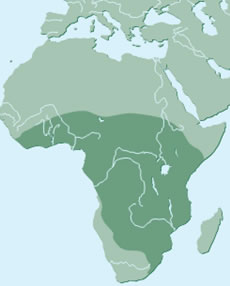 |
| African Elephant |
The African elephant is the world’s largest living land mammal. An average adult male stands 10 feet (3 meters) tall at its shoulder and weighs between 11,000 and 13,000 pounds (5,000 and 5,900 kilograms). Females are a little shorter in height and weigh about 8,000 pounds (3,600 kilograms).
The animal’s thick and loose skin is dark, muddy gray in color. Its large ears, up to 42 inches (107 centimeters) in diameter, hold many prominent veins. To cool its blood during the heat of the day, the African elephant flaps its ears vigorously.
Its long, white tusks are actually elongated incisor teeth. It has only four other teeth, all molars, that it uses to grind down food. These teeth are replaced up to six times as they wear away periodically during an average elephant’s seventy-year life span.
  |
Besides its tusks, a unique feature of the elephant is its trunk, which is an extension of its nose and upper lip. The animal uses its trunk for drinking, bathing, smelling, breathing, feeling, greeting, communicating, and grasping. The African elephant has two finger like tips at the end of its trunk that are sensitive enough to pick up very small objects.
African elephants are herbivores (plant-eaters), consuming tree bark, fruits, grasses, and leaves of trees and shrubs. They require approximately 300 to 400 pounds (135 to 180 kilograms) of food and 50 gallons (190 liters) of water a day.
The animals never stray far from a source of water, which they use for drinking, bathing, and cooling. After bathing each day, the elephants coat themselves in dust and dirt for protection against insects.
Elephants are social animals that form strong family ties. Family units or herds are made up of females (called cows) and their young (calves). The entire herd is led by an older cow called the matriarch, to which all other members of the herd are related. When a member of the herd dies, other members “grieve” over the loss, covering the dead elephant with leaves and twigs and staying by the grave for hours.
Older male elephants (bulls) live by themselves or with other males in small groups called bachelor herds. They associate with females only to breed. After a gestation (pregnancy) period of almost two years, a female elephant gives birth to a single calf, which weighs between 200 and 300 pounds (90 and 136 kilograms).
Other females are often present during the birth and help keep predators away. The calf nurses for at least two years and remains dependent on the mother for four to five years.
Habitat and current distribution
African elephants are found in most areas of Africa south of the Sahara Desert. Those elephants living in central or western Africa inhabit forest areas, while the elephants in the eastern and southern regions of the continent live in savanna and bush habitats.
In 1998 elephant specialists estimated the African elephant population on the entire continent of Africa to be a “definite” 301,773 animals, or a “speculative” total of 487,345 animals. Since many areas were not surveyed and because elephants in the forests are difficult to count, these figures are rough.
History and conservation measures
African elephants have been hunted for centuries for their tusks, which are composed of ivory. This substance has been used to make items ranging from jewelry to piano keys. The animals once ranged in northern Africa up to the Mediterranean coast, but they became extinct there during the European Middle Ages (450–1450).
As the human population in Africa continues to grow, the elephant’s habitat continues to shrink. In the late 1970s, African elephants numbered approximately 1,500,000. Less the 20 years later, that number has been decreased by two-thirds.
The greatest threat to the future of African elephants continues to be poaching, or illegal killing. Steps have been taken to protect the animals from poachers. Several African countries have established elephant conservation programs. National parks and reserve areas have been set aside to safeguard the animals and allow tourists to see them in their natural habitat.
In 1989, the Convention on International Trade in Endangered Species of Wild Fauna and Flora (CITES; an international treaty to protect wildlife) adopted a ban on the sale of elephant ivory.
The international market for ivory immediately decreased. In June 1997, that ban was lifted when a majority of CITES member nations voted to allow the African countries of Botswana, Namibia, and Zimbabwe to sell 59 tons of stockpiled elephant tusks to Japan.
The sale, estimated to bring in $30,000,000, was allowed as a reward for the conservation efforts of the three countries. Opponents of the sale believed it would simply encourage renewed African elephant slaughters by poachers.
